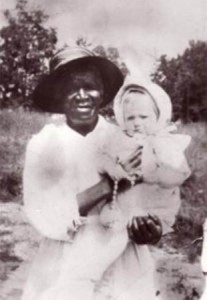History of slavery in Colorado facts for kids
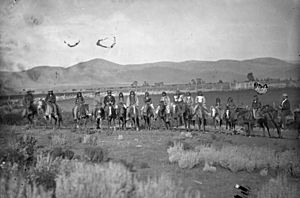
The history of slavery in Colorado started many years before Colorado became a state. Spanish colonists from Santa Fe de Nuevo México (1598–1848) enslaved Native Americans. These enslaved people were known as Genízaros. Southern Colorado was part of this Spanish territory until 1848. Comanche and Utes also raided other Native American villages and enslaved people.
Colorado's journey to becoming a state was partly slowed down. This was because it needed to allow African Americans to vote. Many African American pioneers came to the area before the American Civil War. One was James Beckwourth, an explorer and mountain man who arrived in 1822.
Charlotte and Dick Green were brought to what is now Colorado in 1833. They worked at Bent's Fort. Clara Brown came looking for her daughter. She became a successful businesswoman and helped others. Barney Ford and Edward J. Sanderlin were also successful business owners. William Jefferson Hardin became a lawmaker and mayor of Leadville.
Some people were enslaved in the early 1800s, like the Green family at Bent's Fort. Many formerly enslaved people later settled in Colorado. They became business owners, lawmakers, and worked in many other jobs.
In 1877, Colorado passed a law making slavery and forced labor illegal. The only exception was for people convicted of crimes. In 2018, a new amendment was passed. This amendment made all forms of slavery or forced labor illegal, even for convicted people.
Contents
Slavery in Spanish America

Native American groups like the Arapaho, Cheyenne, and Utes lived in what is now Colorado for centuries.
Spanish colonists from Santa Fe de Nuevo México (1598–1848) captured and enslaved Utes and other Native Americans. The Spanish created a large slave trade of Native Americans. These enslaved people were called Genízaros. They were sold to Hispanic people in what is now the American Southwest.
By the late 1700s, about one-third of the 29,000 people in New Mexico territory were enslaved. Even after the United States took over the region, some Native Americans were still held as slaves.
Apache, Jumanos, and Kiowa villages were raided by Utes and Comanche riders. Children and adults were captured and sold in other villages.
Early 1800s
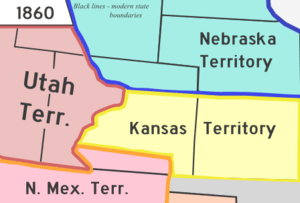
Before the Colorado Territory was created, other territories covered parts of present-day Colorado. These lands came from the Louisiana Purchase (1803) and later treaties.
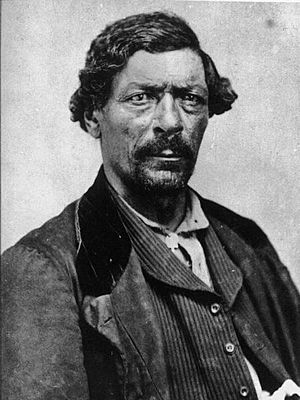
James Beckwourth was born into slavery in Virginia in 1805. He managed to escape. He traveled west, reaching the Colorado area by 1822. He explored the Rocky Mountains and was a fur trapper. He also helped start El Pueblo.
Bent's Fort was built along the Santa Fe Trail in 1833. Native Americans, Spanish, Europeans, and French people visited it. Sometimes, enslaved people came with these visitors. William Bent had three enslaved African Americans: Charlotte and Dick Green and Andrew Green.
The men did maintenance and chores at the fort. Charlotte was the cook and hosted parties. For example, she held a party for General Stephen Kearny. Beckwourth, who was a free and respected mountain man, worked for Bent. The Greens were brought to the fort by William and Charles Bent from St. Louis.
Charles Bent took Dick Green with him to Santa Fe when he became governor of the New Mexico Territory. When Charles Bent was killed, Green helped the soldiers find those responsible. Because of his bravery, William Bent set the Greens free.
In 1848, the United States gained land that would become Colorado. This happened after winning the Mexican–American War. At that time, few Anglo settlers lived in Colorado. The first lasting settlement by people of European heritage was in the San Luis Valley in 1851.
After Utes raided El Pueblo (now Pueblo, Colorado) in 1854, a young boy named Juan Isidro Sandoval was captured. He was enslaved for eight years. He was later freed in exchange for a Hawken rifle and $300 (equivalent to $8,794 in 2022) in silver.
Colorado Territory
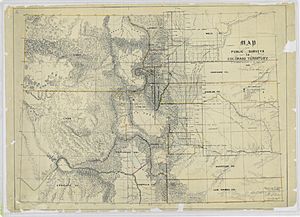
The Colorado Territory (1861–76) was created on February 28, 1861. This happened because many people came looking for gold during the Pike's Peak Gold Rush. Before the American Civil War, there was a disagreement between pro-slavery Democrats and anti-slavery Republicans in Congress.
Republicans were able to pass the Colorado Organic Act in February 1861. On August 1, 1876, President Ulysses S. Grant officially made Colorado a state.
African American Pioneers
In the mid-1800s, Black people came to Colorado with other gold seekers. They lived in and around Denver, Boulder, Cripple Creek, and Central City, Colorado. Many Black soldiers from the 9th and 10th United States Cavalry, known as Buffalo Soldiers, settled in Colorado after their military service.
Formerly Enslaved Individuals

Clara Brown was born into slavery and had four children. Her family members were separated. After she was freed, Brown traveled west to find one of her daughters. She worked as a cook for a wagon train. She was the first African-American woman to settle in Colorado. She became a successful businesswoman and helped many people. After searching for 47 years, she finally met her daughter Eliza. Eliza moved to Denver to live with her.
Elijah Wentworth, known as "Lige," was born into slavery. He knew nothing about his family or early life in Virginia. He also cooked for a wagon train heading to Denver. Wentworth was a singer and a town crier. He was well-known for being at Union Station.
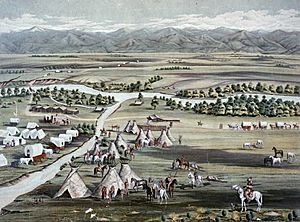
Barney Ford was an enslaved man from Virginia. He escaped using the Underground Railroad. He lived in several places before settling in Denver. He fought for civil rights and was a successful businessman. He helped freed slaves get an education.
Samuel and Nancy Lancaster earned money to buy their freedom. A pastor in Kansas gave $600 to pay for Nancy's freedom. Samuel worked in mining camps as a barber. He earned $1,200 (equivalent to $28,521 in 2022) to buy his own freedom. The couple lived in a cabin in Denver.
Edward J. Sanderlin was born into slavery. He became a successful businessman in Denver. John Taylor, born enslaved in Kentucky, served in the Civil War. After the war, he fought Native Americans. After leaving the army, he joined a group of Utes and settled in the San Juan Valley.
Free Black People
Henry O. Wagoner helped people escape slavery on the Underground Railroad before moving to Colorado. He worked for civil rights. He paid legal fees for fugitive slaves. William Jefferson Hardin, born free in Kentucky, came to Colorado in 1863. He became the mayor of Leadville. He fought for civil rights and was the first African American elected to the Wyoming Territory Legislative Assembly.
Civil War and Freedom
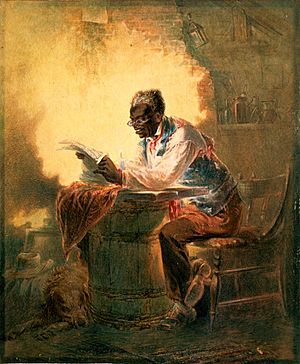
The Emancipation Proclamation was put into effect on January 1, 1863. This happened during the American Civil War. However, it wasn't until June 19, 1865, that all enslaved people across the country were freed.
The end of the Civil War gave free Black people a chance to settle outside the South. The "Wild West" likely still had some unfair treatment. But it didn't seem to have the same fear of Black people as the South. This might be because many white people in Colorado were from other countries. Also, not many white Southerners moved to Colorado after the war.
In 1860, there were 46 Black people recorded in Colorado. Ten years later, there were 456. White people in Colorado seemed to have more fear of Asian Americans and Native Americans. In Colorado, where the number of Black people was small, it was often better to hire a Black person than an Asian, Native American, or Italian person. One historian said that "black life in the West varied from other parts of the U.S." This was because large Asian, Latino, and Indigenous populations often received the unfair treatment that African Americans usually faced.
Julia Greeley was born enslaved in Missouri. She lost an eye and was hurt by a whipping. She came to Colorado after she was freed. She worked for Julia Dickerson and William Gilpin for at least three years. After their divorce, she worked as a domestic servant. Even though she didn't have much money, she gave food and clothes to the poor. She also cared for children and shared the Catholic faith. An icon of Julia was created by the Archdiocese. It shows her with a child, Colorado mountains, the Sacred Heart, and other important images.
On November 15, 1865, the Zion Baptist Church was founded. Its members included formerly enslaved people, activists, teachers, doctors, preachers, and politicians. They played very important roles in the city and beyond.
Colorado Statehood
Colorado Territory wanted to become a state during the American Civil War. A main issue was whether African Americans would have the right to vote. In 1867, President Andrew Johnson rejected a bill for statehood that would have given Black people the right to vote.
In 1877, Colorado officially outlawed forced labor and slavery. The only exception was as a punishment for convicted criminals. In 2018, Colorado Amendment A was passed. This amendment completely ended slavery. It made it illegal to force convicted criminals to work. The words for this law are based on the Thirteenth Amendment to the United States Constitution.
The state constitution now says, "There shall never be in this state either slavery or involuntary servitude." This law now stops formerly enslaved people from being arrested and forced into "involuntary servitude." This was also known as "convict leasing."
Remembering History
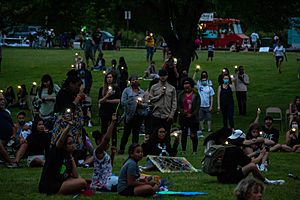
Juneteenth celebrations began in Denver in the 1950s. This day remembers the freedom of African Americans. It also focuses on education and achievement. By the 1980s, Denver's Juneteenth was one of the largest celebrations in the country.
In 2012, Juneteenth Music Festival LLC was started. Its goal was to make the festival strong again, as it had declined since the early 1990s. It helps with improving and removing financial problems in Denver, Colorado’s Historic Five Points Neighborhood.


